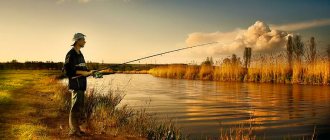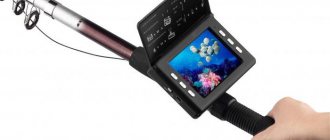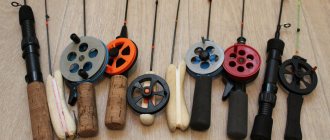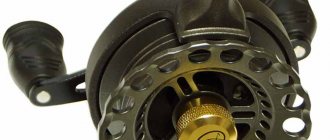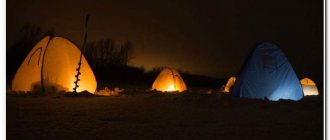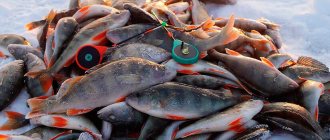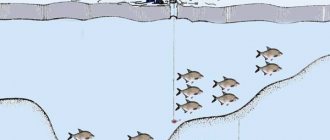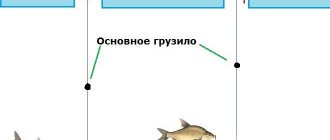Roach Habitats | Search for Roaches
On rivers, large roaches love places with steep banks, washed away by the current. Such places are not difficult to identify visually; they are identified by a certain bend in the riverbed.
The search for roach in such places begins with drilling several holes, starting from the very shore, moving away towards the depths.
It has been noticed that roach in such places stay at depths of 4-5 meters, but not deeper. Therefore, when you find such an edge, we recommend that you linger on it and try to catch it better.
As a rule, when you find a roach and a well-fed hole, you come across not only roach, but also good bream and even 1 - 1.5 kg. bream.
It is worth knowing that in some cases, promising holes do not immediately give any results. Only persistence, along with properly selected bait and periodic feeding of the hole, will give a positive result.
It is imperative to add animal bait to the bait. Bloodworms are often used for this, since it is with this that roaches are caught.
There are quite a lot of variations of different baits and complementary foods, we won’t dwell on that now. Let's talk about this in another article dedicated to roaches.
You can view all the material dedicated to “Roach” in the section: Roach Fishing, or use the site search.

Tactics for finding fish on the river in winter.
Sometimes, in order to find a catchable place, some fishermen spend the whole day and after they find a catchable place, they simply simply do not have time left for fishing. And therefore, the time spent searching for a catchable place should be kept to a minimum.
Even before going fishing, you need to select some points where there are depth differences, edges and other characteristic features of the river bottom. It is advisable to choose not one such place, but several, so that if there are no bites in one place, move to another.
Having arrived at such a point, you need to immediately make several holes and start drilling from the shore towards the middle of the river and the bed. We make the holes so that they are at different depths. Depending on what kind of fish we catch, if it is a peaceful fish, then we immediately need to feed these holes. And then, with one fishing rod, carry out a quick fishing and highlight those holes that gave you the result. And then you can narrow down the search location and drill around the holes that gave you the result.
This is where we will end today.
Where to Look for Roach in Estuaries
In small rivers, in places where they flow into large rivers or reservoirs, you should start looking for roach no earlier than mid-February. This is under conditions that the winter is warm, thereby attracting roaches with a stream of fresh water.
But under no circumstances should this force you into rigid boundaries. According to our observations, a large concentration of roach was noticed both closer to the mouth and 1-2 km away. from the confluence of the river.
There are a huge number of favorable and promising places for roach, for example places with steep banks, as we wrote about above. Here you need to take into account everything, every detail, as well as the convenience of the fisherman.
3 ways to improve your fish bite!
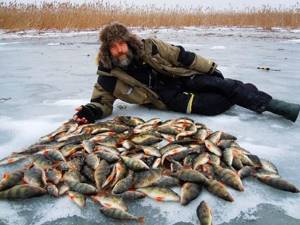
Over 15 years of active fishing, I have found many ways to improve the bite, and here are the most effective:
1. Bite activator . This pheromone additive attracts fish most strongly in cold and warm water. The Fish Hungry bite activator has proven itself to be excellent - Read more…
2. Tackle with increased sensitivity . You should first familiarize yourself with the features of using a particular type.
3. Pheromone baits . They attract the attention of fish, stimulate hunger and cause a schooling reflex, which allows you to collect a lot of fish in one place.
You can get the rest of the secrets of successful fishing for free by reading my other materials on the site.
3 ways to improve your fish bite!
Over 15 years of active fishing, I have found many ways to improve the bite, and here are the most effective:
1. Bite activator . This pheromone additive attracts fish most strongly in cold and warm water. The Fish Hungry bite activator has proven itself to be excellent - Read more…
2. Tackle with increased sensitivity . You should first familiarize yourself with the features of using a particular type.
3. Pheromone baits . They attract the attention of fish, stimulate hunger and cause a schooling reflex, which allows you to collect a lot of fish in one place.
You can get the rest of the secrets of successful fishing for free by reading my other materials on the site.
For example, when there is a strong wind, sitting at the mouths of rivers is not very comfortable, so it is best to look for roach near steep banks.
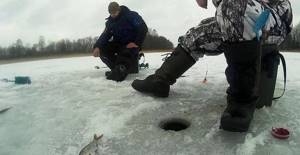
Where to Look for Roach on the Reservoir
In the waters of a huge reservoir, finding roach quickly is not so easy, especially in the middle of winter. It is advisable to avoid areas with strong currents. Look for the flattest bottom tables, with flooded beds of small rivers or lakes.
It is desirable that there are driftwood at the bottom. If you have the opportunity to ask local fishermen, do so. Thus, you will greatly reduce your search time and save energy.
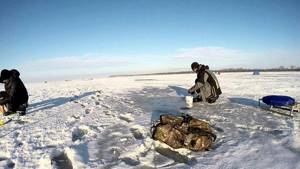
The depth for searching for roach is approximately 3.5 - 5 meters, uneven bottom, holes, small differences in depth, snags. A small, flat table, among riverbeds, holes and steps, is the best option for feeding and catching roach.
For example, at one reservoir, I often came across large roaches in places where the river bed was flooded, which ran near some bay.
All you had to do was look for changes in depth near the riverbed, and if there were snags at the bottom, then be sure that there were roaches there! And once, I caught half a hundred roach tails near a steep bank, where a fallen tree was frozen into the ice. There were also frozen bushes sticking out from behind the ice nearby.
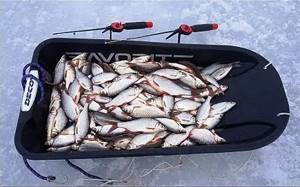
It is worth noting that in the dead of winter, in stagnant and heavily silted areas of the reservoir, you will not find roaches. This is due to the low oxygen concentration in this area.
Finding a plant, driftwood, or just a branch covered in shells or any animal organisms at the bottom indicates that there is enough oxygen and food supply in this place. This is an excellent reason to linger in this place and feel it thoroughly. Rest assured, you won't be disappointed.
Fish in winter and how to find a fishing spot during winter fishing
39
(37 votes, average 2.78 out of 5)

The winter period, which covers the time when a reservoir is under ice, is usually divided into “first ice”, dead winter and “last ice”. Changing environmental conditions force fish to change their stopping place and behavior. Fishermen, just like fish, must, in turn, adapt to new conditions.
In order for winter fishing to be more successful, the angler needs to know what factors influence the behavior of fish in winter and how to determine the places where they may accumulate in a winter reservoir.
Fishing on the first ice. Undoubtedly, fishing on the first ice is a pleasure. But only classic places can provide a good catch even in this fleeting time. The point is that the principle that operates in late autumn remains relevant during the freeze-up period. The fish head to the classic places where they gather in schools, being in readiness mode for the appearance of the first ice. With the appearance of the first ice on the reservoir, the fish continue to remain in such places for some time.
Classic places that attract fish must meet three basic requirements: the fish must find food there, shelter and feel safe. The main factors that attract it are the same regardless of whether the reservoir is an oxbow lake, a natural lake or a dam.
To find fish on a winter body of water, focus on three of these main factors: shallows, current and bays, although many other factors can be considered.
Shoals in all their manifestations - be it vast shallow water, small ledges, underwater mounds, the remains of a dam - are the most obvious and important structural elements of a reservoir. Large shallows attract significant numbers of fish; Productive shallows are typically characterized by a range of favorable conditions. Productive shallows often have an uneven bottom surface.
Algae and fallen trees, for example, attract small animals and large predators. Many species prefer to feed in places with a clear bottom, although such places are usually found near a depth difference. Each species has its own preferences, congregating in an area of the body of water that meets its needs during a period of cold water, and remaining there until the body of water freezes.
The presence of a border where one specific area passes into another is also an important factor. For example, a place where the depth abruptly turns into a shoal; an area where sand turns to pebbles or silt to sand, algae and fallen trees to a clear bottom. Piglets and grooves on the edge of the shallows, a carpet of algae or an area with fallen trees are often places where fish accumulate .
Current is another classic aspect that attracts fish to a specific location in a body of water. Flow in lakes and reservoirs is associated with flowing streams or springs. It is also present in places where the lake is narrowed like a river or canal.
Of course, other components are also necessary for a place to attract fish with the current. For example, pike perch usually sticks to the current passing over a rocky shoal near the main depth difference. Many pike perch prefer to be in these places on the first ice. Remove this difference in depth or shallow area and the area with current will be of no interest to the toothy predator.
As you can see, flow is a key component, but not the only one. Fishing preferences vary, but current is usually the main factor that attracts fish when ice forms. But where there is a current, the ice can be thin. Therefore, be extremely careful!
Bays are the third major factor. Small shallow bays only occasionally attract fish. Whereas medium and large bays with decent depth, capable of supporting fish throughout the year, are of great importance. These bays (narrow branches in lakes and reservoirs, dams in rivers) provide fish with food better than the body of water itself, and serve as a home for predators and their prey.
Medium-sized bays often attract some species of fish, even though they lack such an important component as a sandbar. However, in most bays, areas with shallows and currents tend to concentrate fish. And sometimes, from the point of view of successful fishing, this allows you to treat the bays as separate lakes.
We should also not forget that the oxygen content in water becomes one of the determining factors in the location of fish in winter. Oxygen no longer enters the water from the atmosphere and is no longer enriched by the wind. And with snow falling, the process of photosynthesis of aquatic plants decreases to almost zero.
According to the first ice, the oxygen content is the same in almost the entire water column - from the bottom to the surface. By mid-winter, oxygen levels can drop several times. The oxygen content decreases most quickly in smaller and eutrophic lakes (an old lake with a large supply of nutrients and high biological activity), in which there are no springs and feeding springs and streams.
Fishing during the low winter season. The highest concentration of oxygen throughout the winter is observed close to the surface. This is because colder water contains slightly more oxygen. After all, at the bottom there is a process of decay of organic substances, as a result of which oxygen is absorbed.
By mid-winter, in smaller, nutrient-rich lakes and ponds, fish can rise right to the surface under the ice. Fish kills in winter are most often observed in small lakes no more than 5 meters deep, in the absence of springs supplying fresh water and sunlight, which is prevented from penetrating into the water column by a cap of snow. If you drill a hole in such a reservoir, then the fish immediately goes there, and you can catch it directly from the hole with your hands or a scoop. A natural spring or stream creates the same effect.
Water at depth contains less oxygen, but it is warmer. The surface water is rich in oxygen, but it is very cold. Combined with the increasing thickness of the ice, these two opposing forces create a “vice” effect for the fish.
In shallower bodies of water, fish are directed towards the bed of the reservoir, even at shallow depths. The movement toward deeper water is less pronounced in relatively nutrient-poor lakes. This movement of fish is not typical in the middle of winter and in mesotrophic lakes (lakes with clean water and an average level of nutritional environment). Some part actually goes to the depths by mid-winter, but this trend is not so pronounced due to the fact that the conditions are not so unacceptable for the life of fish.
There are, of course, exceptions. If the winter has little snow, the fish stay in shallow water longer and return there earlier. Sources of fresh or warm water (springs, streams, etc.) also attract fish. Before the onset of the “vice” period, many fish species are most active in winter. As soon as the “vice” pressure increases, the greatest activity occurs mainly at depth.
During the deep winter, the fish may be more concentrated, but they do not feed as actively. Metabolism decreases significantly at this time. When winter fishing during the dead of winter, you can count on a good catch only with a delicate presentation of the bait, delicate play with a sensitive fishing rod and nod and tiny jigs. Walleye anglers should move to deeper areas and concentrate on fishing very early in the morning and before dusk.
Fishing on the last ice. At the end of winter, daytime temperatures can rise above freezing and the ice melts, starting at the top of the ice cap. As it melts, the reverse process occurs. First the snow cover melts. Then it comes to the top layer of ice, it acquires a porous structure.
Near the shore, the ice also begins to melt. Under the influence of heated soil, the ice cover in this area disappears much faster than in the entire reservoir. To get out onto the ice, fishermen have to cross this water obstacle. But, above all, fishermen must be guided by safety measures. Eventually, the ice turns black, the sun and high temperatures corrode it, making it porous, brittle and unsafe even when thick.
According to the last ice, the most promising places for fishing are in shallow water, but the reasons for this are rarely discussed. The “food chain” returns to areas with shallow depths, especially shallow bays. For a month or two, as the fish move into deeper bays and lake mouths, the plankton population gets a break and has a chance to recover. During this period, small fish return to places rich in plankton, feeding on it, medium-sized fish hunt small fish, and larger predators, in turn, eat both small and medium fish.
Based on what was described above, we can formulate principles for searching for places where fish accumulate in winter . They are quite simple:
- availability of food;
- suitable temperature;
- suitable oxygen level.
Other
Finding Roaches in Late Winter
The place for catching roach at the end of winter is somewhat different from the place at the beginning or middle of winter. Let us note several features. In March and April, the main accumulation of large roach occurs precisely in the silted areas of the reservoir closer to the shore.
The remaining signs are the same as those described earlier: a flat table, a weak or completely absent current, the presence of snags. All this indicates the presence of roach in this place.
The largest concentration of roach occurs in an area of 30-50 meters, with ditches and depth differences of 0.5 meters at the bottom. The depth at the fishing spot is the same - 3.5 - 5 meters. At this time, the roach is slowly beginning to take a liking to spawning sites.
Such places generally do not offer a huge food supply, but still shelter from predators, and the optimal depth for roach to live in, forces it to stay in this particular place and nowhere else.

Let's take a look at the flora of the reservoir
The popular saying that where there are many fishermen, there are fish, does not always work, so when choosing a place for fishing, it is better to be guided by more effective methods, choosing plants growing in the reservoir as a guide.
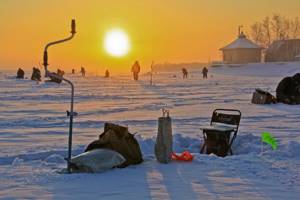
Fish love horsetail, so where this grass grows at the beginning of winter you can catch perches of various sizes. But if, after casting your fishing rod, you pull out an elodea on the hook, then there are no large fish here, perhaps you should move. When you take out a leaf of pondweed from the bottom, you can rejoice - there is a chance to catch a large fish.
